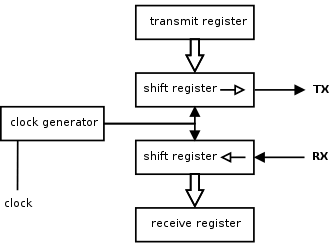In this blog post, you will know the difference between UART and USART (UART vs USART). Both UART and USART chips are made by manufacturers to convert incoming and outgoing bytes of data into a serial bitstream.

As an embedded engineer it is good to know the actual differences between UART and USART.
Why I am saying this because there are many newbies who think that UART and USART both are the same. But in reality, both are different from each other and they have different properties. UART stands for Universal Asynchronous Receiver Transmitter while USART stands for Universal Synchronous Asynchronous Receiver Transmitter.
The main difference between the UART and USART peripheral is that the UART peripheral supports only asynchronous mode, whereas USART supports both synchronous and asynchronous modes.
If you don’t know what asynchronous and synchronous communication mode is. Don’t worry before explaining the difference between UART and USART I will explain these communication modes.
Asynchronous Serial Transmission:
In asynchronous communication, there is no common clock between the sender and receiver. It is widely used for byte-oriented transmission which means it can send 1 byte or character at a time. Asynchronous communication is slow as compared to synchronous and also it has the overhead of start and stops bits. That means, in asynchronous communication, each frame is wrapped with start and stop bit. Let’s see the frame structure of asynchronous communication.
Frame structure in Asynchronous Communication:
Mainly it consists of 5 elements:
Start Bit (logic low (0)): Each frame starts with a START Bit and it is always low. The start bit signals the receiver that a new byte is coming.
Data Bits: Data bits can be 5 to 9 bits packets. Normally we use 8 data bit packet, which is always sent after the START bit.
Parity Bit: If a parity bit is used, it would be placed after all of the data bits.
Stop Bit (logic high (1)): It can be one or two bits. It is sent after the data bits packet to indicate the end of the frame. The stop bit is always logic high.
Idle (logic high (1)): It is no data state always high.
See the below example of a UART frame. In which, one byte is sent, consisting of a start bit, followed by eight data bits (D0-7), an optional parity bit, and one stop bit. It starts with the “start bit” and ends with the “stop bit”.

Synchronous Serial Transmission:
In synchronous communication, the clock is shared by the sender and receiver. In which we can transmit a block of data and for the block of data only one start and stop bit. it is the reason synchronous communication has less overhead.
Difference between UART and USART (UART vs USART):
Let’s see some other common differences between the UART and USART (UART vs USART) step by step.
|
UART |
USART |
|
|
|
|
|
|
|
|
|
|
|
|
|
|
|
|
Recommended Post:
- Can protocol Interview Questions.
- 100 C Interview Questions.
- 100 embedded C Interview Questions.
- Difference between SPI and I2C.
- I2C Interview Questions
- Interview questions on bitwise operators in C
- C++ Interview Questions.
- 10 questions about dynamic memory allocation.
- File handling in C.
- Pointer in C.
- C format specifiers.
